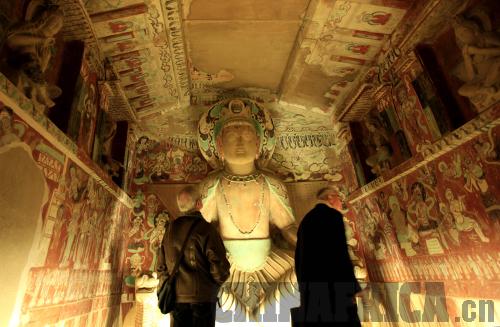|
 |
|
NATIONAL TREASURES: Extreme measures are taken to preserve the Mogao Grottoes |
More than 5,000 years of civilization has left China with around 700,000 historical heritage sites across the country. These precious treasures and landmarks have become the motivating force behind the nation's booming tourism. However, commercialism is beginning to pose a threat against their protection. Finding a balance between the past and the forces of modernity is a task that China must now undertake.
Protective measures
Located in Dunhuang City, Gansu Province, the Mogao Grottoes is one of three noted grottoes found in China. It is also one of the largest, best-preserved and richest sites of Buddhist art in the world.
Here, 735 grottoes of different sizes are scattered along a 1,600-meter cliff. The murals housed inside them feature myriad artistic styles from China's many dynasties.
For many visitors, though, the gorgeous history on display is not the only surprising feature at the site. It's also the sheer amount of measures in place meant to protect the art. The murals are delicate and struggle to survive amidst booming tourism.
The grottoes can only receive 2 million tourists annually, since carbon dioxide exhaled by people accelerates deterioration of the murals. Apparatuses have been set up to monitor humidity inside each grotto, and grottoes will be closed if any recorded number crosses the standard line.
There are several different possible tour routes to cover 10 of Dunhuang's grottoes. Together, these 10 represent all of the artistic periods found among the site's hundreds of other grottoes. With one ticket purchase, a tourist will find himself set up with a professional guide, on his way to learning more about Buddhist history.
Liu Hongli is a grottoes guide. Her job is twofold. She explains the history and religious meaning behind the murals, and – perhaps more importantly – she unlocks and then locks the wooden doors that protect the art inside the caves. Unlike the murals, these doors aren't relics of the past; they were built relatively recently. No one may enter through them without permission.
Liu and her colleagues are not typical tour guides. To be a key-holder at the grottoes, a graduate degree is required alongside a deep knowledge of history, art and religion in order to understand the value of the Mogao Grottoes.
According to Liu, among the over 400 grottoes housing murals and sculptures, only 40 are open to tourists.
Soon, she says, this number will be halved "when the new exhibition hall is finished outside the Mogao Grottoes. It will take no longer than two years." The new hall will give visitors a chance to experience the grottoes in 3 dimensions (3D).
This news may disappoint Mogao admirers. But as a management system, the 3D theater is far from enough. "Even this protection cannot compete with natural erosion in the grottoes as time passes," explains Sun Xuehu, an official with the Dunhuang City Government. Still, he says, "I bet they are the least commercialized historical relics in the country."
|